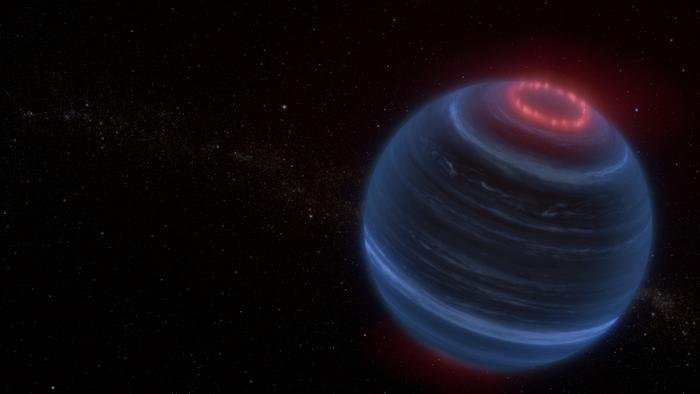In a groundbreaking discovery made possible by NASA’s James Webb Space Telescope, astronomers have uncovered a brown dwarf named W1935 that exhibits unique characteristics.
Unlike anything previously observed, this cosmic body, which is larger than Jupiter but not quite a star, glows with infrared emission from methane, hinting at mysterious processes occurring in its upper atmosphere.
This concept image depicts brown dwarf W1935, where NASA's James Webb Space Telescope detected unexpected methane emissions, possibly caused by aurorae processes in the cold, starless dwarf. - (Image Credit: NASA, ESA, CSA, and L. Hustak (STScI))
This revelation was announced at the 243rd meeting of the American Astronomical Society in New Orleans and has perplexed scientists. The intrigue lies in the fact that W1935, being a cold object without a host star, should not have an obvious energy source to heat its upper atmosphere, where the methane emission is occurring. The team, led by Jackie Faherty from the American Museum of Natural History, suggests that the phenomena might be akin to aurorae, similar to those seen on planets like Jupiter and Saturn in our solar system.
Aurorae Beyond Our Solar System: A New Cosmic Phenomenon
In our solar system, aurorae are mesmerizing light displays caused by solar winds interacting with planetary magnetic fields. For planets like Jupiter and Saturn, aurorae are also influenced by active moons like Io and Enceladus. However, for a lone brown dwarf like W1935, without a nearby star or stellar wind, the source of energy causing this auroral-like phenomenon remains a puzzle.
The story unfolded as Faherty's team was studying 12 cold brown dwarfs using the Webb telescope. They noticed that W1935, along with another object named W2220, had similar features except for the unexpected methane emission from W1935, contrary to what was observed in W2220.
Further investigation using computer models revealed a striking difference between the two objects. While W2220 showed a typical energy distribution, W1935 displayed a temperature inversion - its atmosphere gets warmer with increasing altitude, a feature typically associated with nearby stars heating the stratosphere. This finding is particularly baffling for an object like W1935, which lacks an external heat source.
Webb's Role in Future Discoveries
W1935 now stands as the first auroral candidate outside our solar system showing methane emission and is the coldest known object of its kind, with a temperature around 400 degrees
Fahrenheit. The absence of a stellar companion in W1935 challenges our understanding of auroral processes, offering a unique glimpse into cosmic phenomena beyond our solar system.
Faherty remarks that this discovery extends a familiar solar system phenomenon into uncharted territory, demonstrating the power of the Webb telescope to delve into the complex chemistry and processes of celestial bodies far beyond our own backyard.
Sources and further reading:
Too busy to follow science news during the week? - Consider subscribing to our (free) newsletter - (Universal-Sci Weekly) - and get the 5 most interesting science articles of the week in your inbox
FEATURED ARTICLES:







